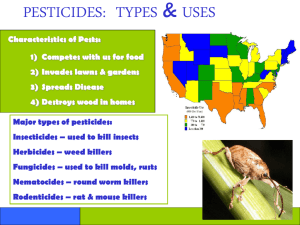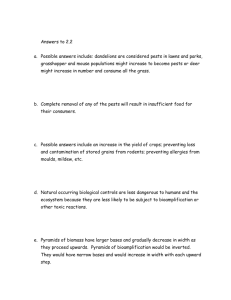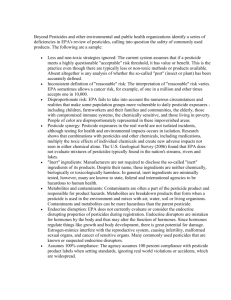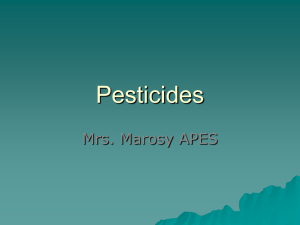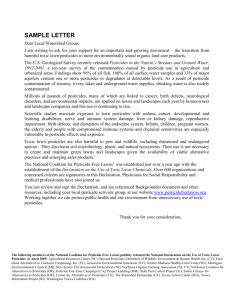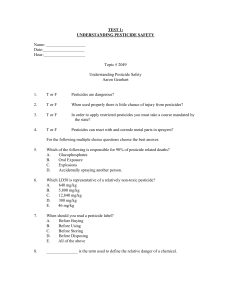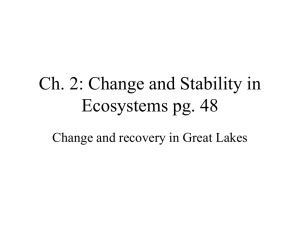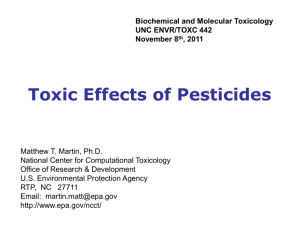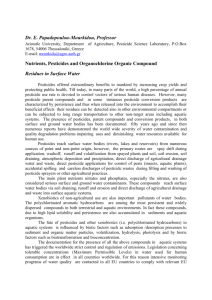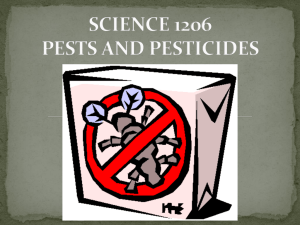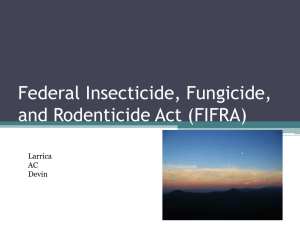History of pesticides - Pesticide Health Effects Medical Education
advertisement
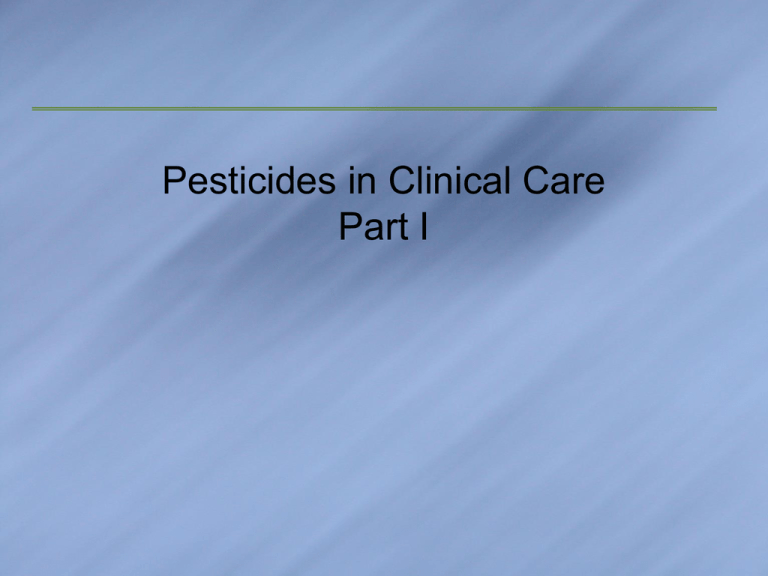
Pesticides in Clinical Care Part I What is a Pesticide? A substance or mixture used for preventing, destroying, repelling, or mitigating any pest. A pest is any harmful, destructive, or troublesome animal, plant or microorganism.” Environmental Protection Agency (EPA) Federal Insecticide, Fungicide and Rodenticide Act What is a Pesticide? Examples Herbicides Generally not very toxic to humans: a few exceptions Fungicides More frequently sensitizers. Some are carcinogenic, mostly not acutely toxic Insecticides Generally acutely toxic group of pesticides Fumigants Gasses that kill most everything Rodenticides Newer rodenticides primarily anticoagulants Disinfectants Nano-silver (a recent EPA decision). Toxicity yet to be determined What Do We Know About a Pesticide? Pesticide Registration by EPA • EPA responsible for registering pesticides – Toxicity tests required in registration process • Acute toxicity (LD50) – Oral, Dermal, Inhalational • Subchronic and Chronic toxicity – Delayed neurotoxicity • • • • • Reproductive toxicity Teratotogenicity Developmental toxicity Mutagenesis-oncogenesis-genotoxicity Metabolism and fate studies What Don’t We Know • Long term effects of low level exposure on human populations • Long term neurodevelopmental effects on humans • Effects of Mixtures • Effects of “inert ingredients” • Effects of some newer pesticides on humans • Non specific toxicological mechanisms and consequences of some pesticides Brief History of Major Pesticides • Prehistory: Sulfur – First seen in Egyptian writings 2400 B.C. and Chinese writings 1500 B.C. – Greek writings • 700 BC Before World War II Metals and Salts Arsenites. Paris Green, A gem of a pesticide - copper acetoarsenite. circa 1867 This was introduced and used first as a pigment, known as Emerald Green, later as a pesticide. Other arsenic preparations and products of the dye industry were also used Paris Purple London Purple The Control of Other Pests • Bordeaux mixture – (copper sulfate and hydrated lime) • First effective fungicide, 1882 – Pierre M. A. Millardet, – French National Hero Before World War II Lead Arsenate Very Important Lead Arsenate to fight the gypsy moth 1892. • Heavily used in much of agriculture • Heavily used in apples • Soil contamination remains a problem today in many old orchard soils in the Northwest Other Non-metalic Pesticides • Pyrethrum – A carefully held secret for many years 1850– Source is Chrysanthemums • Nicotine – Widely used until WWII – Extremely toxic (LD50 = 1mg/kg) Discover of New Insecticides • Discovery of organophosphates – – – – – Gerhard Shrader: A German Scientist Attempting to replace Nicotine Developed organophosphate esters Tabun, sarin, soman (G gases), parathion First to be poisoned by nerve gas (tabun) Discover of New Insecticides • DDT – First synthesized by a German graduate student Othmar Zeidler in 1873 – Rediscovered by Paul Mueller, a Swiss entomologist, in 1939 – World War II, Use of DDT to control typhus and malaria. Paul Müller Nobel Prize 1948 • “My fly cage was so toxic after a short period that even after very through cleaning of the cage, untreated flies, on touching the walls fell to the floor. I could only carry on my trials after a thoroughly cleaning and after that leaving it for about one month in open air.” Muller Nobel Prize acceptance speech 1948. DDT Safe, Effective, Inexpensive Used Everywhere Rachael Carson: A Silent Spring – January 1, 1973 (EPA) canceled all uses of DDT in the US – By the time of its cancellation, more than 1 billion kilograms of DDT had been introduced into the United States. When Did We Become Aware of Pesticide Health Issues? • Physicians discussed Lead and Arsenic toxicity in the 1700-1800s • Animal & human studies on arsenic up to 1940s • The new pesticides showed some early problems – – – – 1950s reports of pesticide toxicity from OP’s & OC’s 1960s Increasing literature about DDT Health effects 1960s 15 labs in US study health effects of pesticides 1966 First organized study of human OP Persistent Health effects Tabershaw and Cooper – Studies of Neurotoxicity of Organophosphates 19702000’s – Parkinson’s and pesticides 1990-2009- still working







